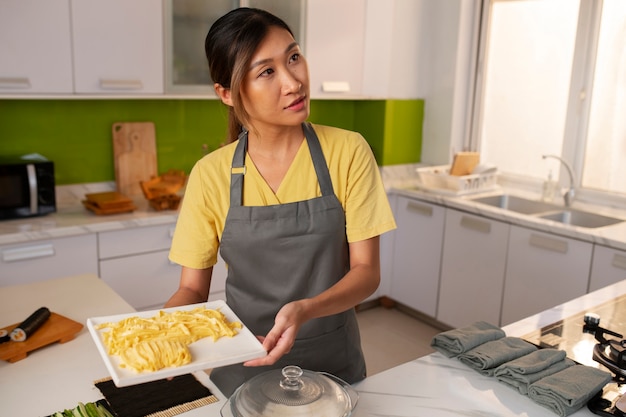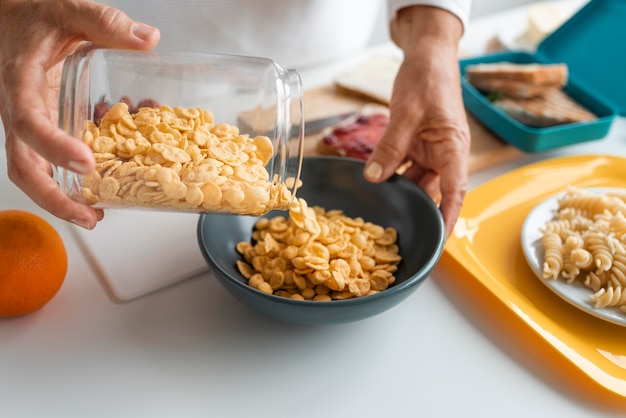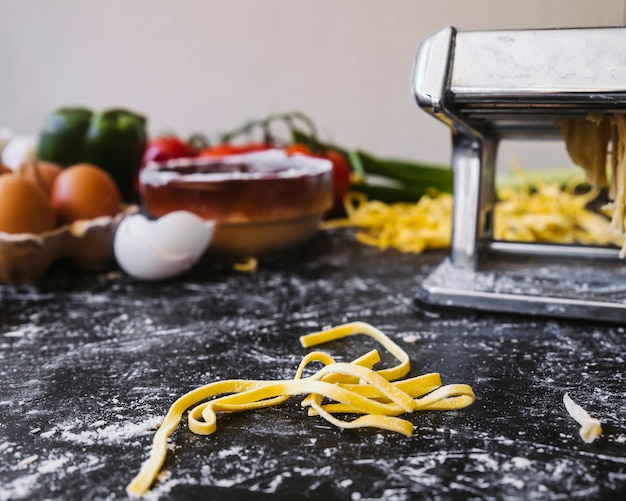Let's be honest, we all love a good pasta dish. But sometimes, the thought of boiling a pot of water, stirring, and draining pasta just feels like too much effort, especially when you're short on time. That's where the magic of the rice cooker comes in. Now, I know what you're thinking: "Pasta? In a rice cooker? That's crazy!" But trust me, it's a brilliant hack, and it's surprisingly effective. I've been using my rice cooker for years, not just for rice, but for quinoa, couscous, and even steaming vegetables. So when I first heard about the pasta in a rice cooker trick, I was skeptical, but after giving it a go, I was blown away. It's so easy, so fast, and the results are surprisingly good.
So, if you're curious about this whole pasta in a rice cooker thing, keep reading. I'm going to walk you through the process, step-by-step, sharing my tips and tricks along the way. We'll cover everything from choosing the right pasta to making sure your noodles come out perfectly cooked. Plus, I'll give you some ideas for delicious pasta dishes you can whip up in your trusty rice cooker. Ready to unleash your inner pasta chef? Let's get started!
(Part 1) The Basics: Choosing Your Pasta and Rice Cooker

Before we jump into the actual cooking, let's make sure we have all the right ingredients. First up, your trusty rice cooker, of course! The good news is that you can use pretty much any rice cooker for this, even your basic, no-frills model. I've used mine, and it worked perfectly. But if you've got a fancier one with all the bells and whistles, go for it! Just make sure it has a "keep warm" function, which is a lifesaver for keeping your pasta warm while you're whipping up your sauce.
Choosing Your Pasta
Now, onto the pasta. When it comes to pasta for your rice cooker adventure, you'll want to pick the right kind. Short pasta shapes like penne, rigatoni, or fusilli are your best bets. They're less likely to get tangled and create a sticky mess. I've even tried macaroni in my rice cooker, and it worked fine. But long pasta like spaghetti or linguine? Let's just say they're not the best choice for a rice cooker. It's a recipe for disaster! They tend to get tangled in the rice cooker, creating a giant knot of pasta, which is a pain to separate.
Don't be afraid to experiment with different pasta types too. Whole wheat, gluten-free, or even fancy artisan pasta all work well in a rice cooker. Just make sure you choose pasta that's cooked al dente, as it'll continue to cook slightly in the "keep warm" setting after you've finished cooking it. That means it'll be perfectly cooked when you're ready to eat it.
(Part 2) How to Cook Pasta in a Rice Cooker: A Step-by-Step Guide

Alright, let's get cooking! Follow these simple steps to make pasta in your rice cooker.
Step 1: Prepare the Pasta
First, you'll need to prep your pasta. Fill your rice cooker with water, just like you would for rice. But, instead of using the usual water-to-rice ratio, you'll need a little more water for the pasta. I typically use a 1:1.25 ratio of water to pasta (for example, 1 cup of pasta to 1.25 cups of water). You can always adjust the amount of water depending on the type of pasta you're using. Just remember that you want enough water to cover the pasta completely.
Step 2: Add the Pasta
Now, it's time to add the pasta. Gently lower your chosen pasta into the water, making sure it's fully submerged. Don't worry if the pasta seems to clump together at this stage; it'll all separate during the cooking process.
Step 3: Cook the Pasta
Close the lid of your rice cooker and select the "cook" setting. This is where the magic happens. Your rice cooker will work its magic, gently cooking the pasta to perfection. How long it takes depends on the type of pasta you're using. Just check the instructions on your pasta package for cooking times.
Step 4: Drain the Pasta
Once your pasta is cooked through, your rice cooker will usually switch to the "keep warm" setting. Now, this is where things get a little tricky: you need to drain the pasta. The easiest way to do this is to use a colander. Simply lift the lid of the rice cooker, carefully tilt the pot over the colander, and let the water drain out.
But if you don't have a colander, don't worry! You can use a slotted spoon to scoop out the pasta, draining off the water as you do so. You can also use a large ladle to scoop out the pasta and water, then set the pasta aside in a bowl while you carefully pour out the excess water.
Step 5: Add Sauce and Serve
Once the pasta is drained, it's time to add your favorite sauce. Go wild! You can use any sauce you like: a simple tomato sauce, a creamy pesto, or even a rich alfredo sauce.
Mix the sauce with the pasta in the rice cooker, or transfer everything to a serving bowl if you prefer. Now, it's time to enjoy your delicious pasta!
(Part 3) Tips and Tricks for Success

I've learned a few tricks along the way, and I'm happy to share them with you.
1. Don't Overcrowd the Rice Cooker
Don't stuff your rice cooker with too much pasta! Remember, the pasta needs room to cook evenly. A good rule of thumb is to fill the rice cooker about two-thirds full. If you're cooking a large amount of pasta, it might be better to cook it in batches.
2. Stir Occasionally
For extra-smooth results, give your pasta a gentle stir halfway through cooking. This helps to prevent the pasta from sticking together. Just be careful, as the steam will be hot!
3. Don't Overcook
Remember, pasta continues to cook even after it's removed from the heat. So, it's best to slightly undercook it. The "keep warm" setting will help finish cooking the pasta while you're preparing the rest of your dish. Just check the pasta every few minutes to make sure it doesn't get overcooked.
4. Add Extra Flavor
Want to add a little extra pizzazz to your pasta? You can! Add a bay leaf or two to the water, or even some garlic cloves for a fragrant boost. Just be sure to remove them before serving!
(Part 4) Pasta in a Rice Cooker: Is It Really Worth It?
Okay, let's be honest, you might be thinking, "Is this really worth the effort?" Especially if you're already familiar with the traditional method of boiling pasta on the stovetop. Well, here's the thing: it's not really about "effort". It's about convenience.
cooking pasta in a rice cooker is a real game-changer when you're short on time or just don't want to mess up the stovetop. It's hands-off, simple, and surprisingly effective. I've found that the pasta turns out perfectly cooked, with just the right amount of "al dente" bite.
Plus, there's something so satisfying about using your rice cooker for something other than rice. It feels like a little culinary adventure, you know? It's like unlocking a secret power of your kitchen appliance.
(Part 5) Beyond the Basics: Creative Pasta Dishes in a Rice Cooker
Now that you know the basics of cooking pasta in a rice cooker, it's time to get creative! Here are a few pasta dish ideas to get your culinary juices flowing.
1. Classic Tomato Sauce
This is a foolproof, always-delicious option. Just cook your pasta in the rice cooker, then stir in your favorite tomato sauce. You can even add some chopped vegetables like onions, garlic, and peppers for extra flavor.
2. Creamy Pesto Pasta
Pesto and pasta are a match made in heaven. Cook your pasta in the rice cooker, then toss it with some creamy pesto sauce. Add a sprinkle of grated Parmesan cheese for extra indulgence.
3. Carbonara
This is a classic Italian dish that's surprisingly easy to make in a rice cooker. Cook your pasta, then stir in a mixture of eggs, Parmesan cheese, black pepper, and bacon. It's rich, cheesy, and utterly irresistible.
4. Pasta Salad
Who needs a boring salad when you can have pasta salad? Cook your pasta in the rice cooker, then toss it with your favorite salad ingredients. Think chopped cucumbers, tomatoes, bell peppers, olives, and a creamy vinaigrette dressing.
5. Spicy Pasta Primavera
For a lighter and more flavorful option, try a pasta primavera. Cook your pasta, then toss it with a mix of fresh vegetables, like broccoli, asparagus, zucchini, and mushrooms. Season with some chili flakes for a touch of heat.
(Part 6) Troubleshooting: Common Pasta Problems
Okay, so things don't always go perfectly smoothly. I've had my fair share of pasta mishaps. But don't worry, most issues can be easily fixed. Here's what to do if you encounter some common problems:
1. Pasta Sticks Together
If your pasta sticks together, it's probably because you didn't stir it enough while it was cooking. Try stirring it more frequently, or use a slightly larger amount of water.
2. Pasta Is Overcooked
If your pasta is overcooked, it's likely because you didn't check it regularly or because you left it on the "keep warm" setting for too long. In the future, try undercooking it slightly, or drain it as soon as the rice cooker switches to the "keep warm" setting.
3. Pasta Is Undercooked
If your pasta is undercooked, it's probably because you didn't cook it long enough or because you didn't use enough water. Check the cooking time on your pasta package, and add more water if needed.
(Part 7) Beyond Pasta: Other Uses for Your Rice Cooker
Look, I know what you're thinking: "This rice cooker business is getting out of hand." But hear me out! I'm not just talking about pasta. Your trusty rice cooker can do so much more! You can use it to cook all sorts of delicious things, like:
1. Rice
Let's be honest, this is the main event. Your rice cooker is a rice-cooking superstar! It can handle all sorts of rice varieties, from white rice to brown rice to even wild rice.
2. Quinoa
Quinoa is a super-nutritious and versatile grain that's a cinch to cook in a rice cooker. It's perfect for salads, bowls, and even desserts.
3. Couscous
Couscous is another quick and easy grain to cook in a rice cooker. It's a great side dish for all sorts of meals.
4. Oatmeal
Start your day with a bowl of warm oatmeal cooked in your rice cooker. You can add fruit, nuts, and seeds for extra flavor and nutrition.
5. Steamed Vegetables
Your rice cooker can also steam vegetables to perfection. Try steaming broccoli, asparagus, carrots, or even corn on the cob for a healthy and delicious side dish.
(Part 8) FAQs
Finally, I'm going to tackle some of the most frequently asked questions about cooking pasta in a rice cooker. These are the ones I hear all the time!
1. What if my rice cooker doesn't have a "keep warm" setting?
If your rice cooker doesn't have a "keep warm" setting, don't fret! You can simply drain the pasta as soon as it's cooked and then add your sauce and serve immediately.
2. Can I cook pasta with sauce in the rice cooker?
It's not recommended to cook pasta with sauce in the rice cooker. The sauce can burn or stick to the bottom of the pot. It's best to cook the pasta separately and then toss it with your sauce.
3. Can I add spices to the pasta water?
Absolutely! You can add herbs, spices, or even garlic to the pasta water for extra flavor. Just be sure to remove any large pieces before serving.
4. What if I don't have a colander?
No worries! You can use a slotted spoon or a large ladle to scoop out the pasta and drain the water. You can also carefully pour out the water, leaving the pasta in the rice cooker pot.
5. What's the best way to clean the rice cooker after cooking pasta?
Cleaning your rice cooker after cooking pasta is a breeze! Just wash the pot with soap and water, and wipe down the lid and any other removable parts. It's really quite simple.
That's it! I hope this comprehensive guide has answered all your questions about cooking pasta in a rice cooker. Now, go forth and cook up some delicious pasta dishes in your rice cooker. You won't regret it!
Everyone is watching

Corn on the Cob: The Ultimate Guide to Perfectly Cooked Ears
Healthy MealsAh, corn on the cob. Just the name evokes images of sunny days, barbecues, and that sweet, juicy flavour that ...

Scallops: The Ultimate Guide to Perfect Cooking
Healthy MealsAh, scallops. Those delicate, sweet, and utterly delicious morsels of the sea. They hold a special place in my...

Spaghetti Squash: The Ultimate Guide to Cooking and Serving
Healthy MealsRemember that time you saw spaghetti squash at the supermarket, looking all bumpy and strange, and thought, "W...

Salmon Cooking Times: Perfect Guide for Every Recipe
Healthy MealsLet me tell you, cooking salmon is an art form. It's all about getting that perfect balance: juicy and tender,...

Ham Cooking Time: How Long to Bake, Smoke, or Boil a Delicious Ham
Healthy MealsAh, ham. It's a classic, isn't it? A real crowd-pleaser, especially around holidays. And when done right, it'...
